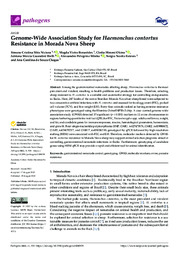Genome-wide association study for Haemonchus contortus resistance in Morada Nova sheep.
Genome-wide association study for Haemonchus contortus resistance in Morada Nova sheep.
Author(s): NICIURA, S. C. M.; BENAVIDES, M. V.; OKINO, C. H.; IBELLI, A. M. G.; MINHO, A. P.; ESTEVES, S. N.; CHAGAS, A. C. de S.
Summary: Among the gastrointestinal nematodes affecting sheep, Haemonchus contortus is the most prevalent and virulent, resulting in health problems and production losses. Therefore, selecting sheep resistant to H. contortus is a suitable and sustainable strategy for controlling endoparasites in flocks. Here, 287 lambs of the native Brazilian Morada Nova hair sheep breed were subjected to two consecutive artificial infections with H. contortus and assessed for fecal egg count (FEC), packed cell volume (PCV), and live weight (LW). Forty-four animals ranked as having extreme resistance phenotypes were genotyped using the Illumina OvineSNP50v3 chip. A case?control genome-wide association study (GWAS) detected 37 significant (p < 0.001) markers in 12 ovine chromosomes in regions harboring quantitative trait loci (QTL) for FEC, Trichostrongylus spp. adults and larvae, weight, and fat; and candidate genes for immune responses, mucins, hematological parameters, homeostasis, and growth. Four single-nucleotide polymorphisms (SNP; OAR1_rs427671974, AR2_rs419988472, OAR5_rs424070217, and OAR17_rs401006318) genotyped by qPCR followed by high-resolution melting (HRM) were associated with FEC and LW. Therefore, molecular markers detected by GWAS for H. contortus resistance in Morada Nova sheep may support animal selection programs aimed at controlling gastrointestinal nematode infections in flocks. Furthermore, genotyping of candidate genes using HRM qPCR may provide a rapid and efficient tool for animal identification.
Publication year: 2022
Types of publication: Journal article
Observation
Some of Embrapa's publications are published as ePub files. To read them, use or download one of the following free software options to your computer or mobile device. Android: Google Play Books; IOS: iBooks; Windows and Linux: Calibre.
Access other publications
Access the Agricultural Research Database (BDPA) to consult Embrapa's full library collection and records.
Visit Embrapa Bookstore to purchase books and other publications sold by Embrapa.

